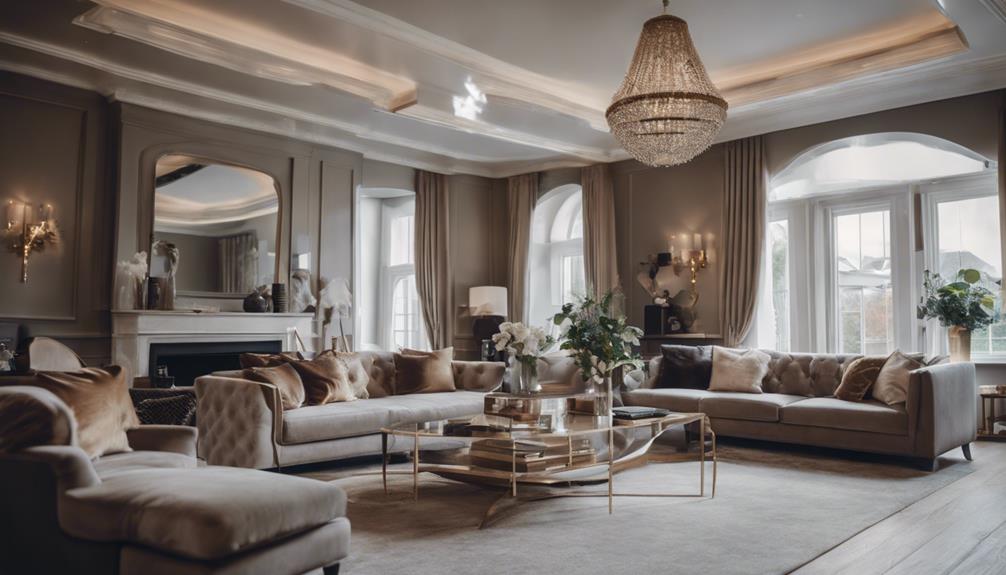The interior of a standard school bus is usually about 6 feet tall. This height is super important for giving you enough headroom and making sure you're comfy during your ride. It also helps the bus fit in all the cool stuff you need for your trip. A higher ceiling means more creative ways to use the space. And if you want to uncover more cool facts about school bus interiors, keep exploring to discover how the height impacts safety, comfort, and customization options!
Key Takeaways
- Standard interior height of a school bus is around 6 feet.
- Ceiling height impacts comfort, safety, and space utilization.
- Higher ceilings enhance accessibility and passenger comfort.
- Customization options available for personalized interior height.
- Future trends focus on modular, safe, and customizable interior designs.
Standard Interior Height of School Bus

When stepping inside a standard school bus, you'll notice that the interior height typically hovers around 6 feet. This measurement is important for ensuring there's enough headroom for passengers to move comfortably within the bus. The ceiling height plays a significant role in determining the overall square footage available inside the bus, impacting how the space can be utilized.
In the domain of bus conversions, understanding the interior height of a school bus is essential for individuals looking to transform these vehicles into homes or other mobile spaces. The standard interior height provides a starting point for planning the layout and design of the conversion. It dictates where lofted beds, storage compartments, and other features can be placed to maximize the use of space while maintaining a comfortable environment.
Whether you're considering a school bus conversion project or simply curious about the dimensions of these iconic vehicles, the standard interior height of around 6 feet sets the stage for a range of creative possibilities.
Importance of Interior Height in School Buses

When it comes to school buses, the interior height plays a vital role in safety, comfort, and space. Guaranteeing adequate headroom not only provides a more pleasant experience but also allows for easier movement inside the bus.
Additionally, having sufficient height ensures accessibility for all passengers, making the journey more inclusive and enjoyable for everyone.
Interior Height Safety
The interior height of a school bus plays an important role in ensuring passenger safety and comfort during transit. Here's why interior height safety is significant:
- Safety: Sufficient ceiling height prevents head injuries and allows for easy movement, reducing the risk of accidents.
- Seating Arrangements: Interior height influences how seats are placed, affecting passenger capacity and overall comfort.
- Modifications: Understanding the ceiling height is essential for making any changes to the bus, ensuring they're safe and compliant.
- Comfort: Higher ceilings provide a more spacious feel, making the journey more enjoyable for everyone on board.
Comfort and Space
To enhance passenger comfort and maximize interior space in school buses, prioritizing sufficient ceiling height is vital. The standard interior height of a school bus is typically around 6 feet, offering ample headroom for most individuals. Some buses even provide optional higher ceilings, reaching around 6'6', to create a more spacious feel.
Understanding the relationship between ceiling height and wall height is essential for interior modifications and maximizing space within the bus. Traditional buses may have wall heights around 5'10' when the center height is 6'6'. Newer models from manufacturers like Blue Bird and Thomas buses feature higher center beam heights, up to 6'6', which not only offer more headroom but also open up possibilities for creative interior arrangements to make the most of the available space.
Accessibility for All
Prioritizing ample interior height in school buses is essential for ensuring accessibility for all passengers. Here's why interior height matters for accessibility:
- Center of the Ceiling: A higher center ceiling allows taller individuals to move comfortably without stooping, enhancing overall passenger experience.
- Side Walls: Varying wall heights impact seating arrangements and standing space, influencing how accessible the bus is for passengers of different heights and abilities.
- Accessibility for All: Adequate interior height ensures that individuals with mobility aids or tall stature can navigate the bus safely and comfortably.
- Interior Height: The overall interior height of a bus determines the level of comfort and inclusivity it offers to passengers, making it a vital factor in promoting accessibility for all.
Benefits of Taller Interior in School Buses

With a taller interior in a school bus, you experience enhanced comfort and spaciousness for various activities. The increased ceiling height not only allows for better ventilation but also creates a more open and airy atmosphere inside the bus. Imagine standing up without having to hunch over and feeling the freedom to move around without constraints.
This added space isn't just for convenience but also for practical purposes like better lighting and improved airflow. In buses like the IC Bus CE Series, RE Series, and Thomas Saf-T-Liner HDX, which offer 78-inch ceilings, you'll find yourself enjoying a more pleasant journey or living space.
Moreover, if you ever consider converting a school bus into a mobile home or a unique space, having a taller interior ceiling will make the conversion process smoother and more enjoyable. So, next time you step into a school bus, appreciate the benefits of that extra headroom and expansive feel it provides.
Considerations for Interior Space in School Buses

When considering the interior space of a school bus, think about the seating arrangements and storage solutions. The layout of seats can impact the overall comfort and capacity of the bus, while clever storage options can help keep belongings organized and maximize space.
Exploring these factors can lead to a more efficient and enjoyable ride for everyone on board.
Seating Arrangements
Taking into account the interior space of school buses plays a vital role in determining the ideal seating arrangements for passenger comfort and safety. When considering seating arrangements, remember these key points:
- The interior height of a school bus impacts the layout of seating, influencing passenger comfort.
- Bench-style seating is commonly used for safety and efficiency in school buses.
- Safety features like red lights and stop signs are essential in ensuring passenger safety, especially in the absence of seat belts.
- Interior space considerations are important for optimizing seating arrangements and enhancing passenger comfort throughout the journey.
Storage Solutions
To maximize interior space in a school bus, consider utilizing under-seat storage bins and overhead compartments efficiently. Installing shelving units or cubbies along the walls can help organize and store items effectively.
Make use of vertical space by incorporating hanging organizers or hooks for bags, jackets, and accessories. Convert unused areas like the back or front of the bus into storage cabinets or closets for bulkier items.
Additionally, incorporating multifunctional furniture pieces such as benches with storage underneath can optimize space usage inside the bus. By creatively utilizing the available ceiling height and interior space, you can find innovative storage solutions that make the most of every inch in the school bus, ensuring a well-organized and efficient layout.
Interior Height Variations in School Buses

The interior height of school buses can vary greatly depending on factors such as the bus manufacturer, model, and optional features offered. Here are some key points to take into account:
- Ceiling Height: Standard school bus interior heights typically range around 6 feet, but some models may offer optional higher ceilings reaching around 6 feet 6 inches for added headroom.
- Wall Height: Wall heights in school buses can vary based on the manufacturer. International buses, for instance, may have lower wall heights around 5 feet 2.5 inches with a peak height of 6 feet 6.5 inches, while traditional buses might've wall heights closer to 5 feet 10 inches.
- Bus Manufacturer: Manufacturers like Blue Bird and Thomas are known to offer models with interior heights reaching up to 6 feet 6 inches, providing more space and comfort for passengers.
- Insulation Impact: Factors such as insulation, flooring thickness, and roof design can influence the overall ceiling height in school buses, leading to variations ranging from 63 inches to over 68 inches.
Practical Uses of School Bus Interior Height

Exploring the practical applications of school bus interior height can provide valuable insights for optimizing space utilization in various projects. The ceiling height and wall height of a school bus play an important role in determining how the interior space can be utilized effectively.
For instance, a higher ceiling height allows for more headroom, making the space feel more open and comfortable. Understanding the wall height is essential for planning interior modifications in a school bus conversion project. By knowing the differences between the ceiling and wall heights, you can design custom storage solutions, seating arrangements, or even sleeping quarters that make the most of the available space.
In a school bus conversion project, the ceiling height can influence the type of lighting fixtures or ventilation systems that can be installed. It can also impact the feasibility of adding overhead storage compartments or creating a raised platform for additional seating. By considering both the ceiling and wall heights, you can create a functional and aesthetically pleasing interior that meets your specific needs and preferences.
Customization Options for School Bus Interior Height

Consider personalizing your school bus interior height to maximize comfort and functionality. When customizing the interior height of your school bus, you have several options to choose from based on your preferences:
- Ceiling Height: Opt for a higher ceiling height, typically around 6'6', to provide a more spacious feel and accommodate taller passengers comfortably.
- Interior Height: Customize the interior height to suit your needs, whether you prefer a standard height or a taller option for enhanced headroom.
- Customization Options: Explore different customization options available from bus manufacturers to tailor the interior height to your liking, ensuring a personalized and comfortable experience.
- Wall Height: Consider the wall height in conjunction with the ceiling height when customizing your school bus, as it can impact the overall feel and functionality of the interior space.
Impact of Interior Height on Passenger Comfort

Enhancing passenger comfort through ideal interior height selection is essential for a pleasant school bus travel experience. The interior height of a school bus plays a significant role in ensuring passengers' comfort throughout the journey. A taller ceiling not only allows taller individuals to stand and move freely but also provides a spacious feel, reducing the risk of feeling cramped during travel.
For those with mobility issues, taller interior heights offer easier navigation and accessibility, contributing to a more comfortable ride for all passengers. Additionally, the overall atmosphere of the bus is influenced by interior height, with taller ceilings creating a more open and airy environment.
When planning modifications or conversions, considerations for interior height are important to guarantee a comfortable ride for passengers. By selecting an interior height of 6'6' or more, school buses can offer a welcoming and comfortable space for passengers to enjoy their travel experience.
Future Trends in School Bus Interior Design

Maximizing space efficiency and passenger comfort drives the evolution of school bus interior design, with innovations like modular seating and integrated technology leading the way. As you step into the future of school bus interiors, here are some exciting trends to look out for:
- Modular Seating Arrangements: Get ready for flexible seating configurations that can adapt to different needs, whether it's group seating for field trips or individual workstations for studying on the go.
- Adjustable Fixtures: Say goodbye to rigid bus interiors. Expect adjustable fixtures that cater to passengers of all sizes, ensuring a comfortable ride for everyone.
- Enhanced Safety Features: From advanced seatbelts to impact-absorbing materials, safety is a top priority in the design of future school buses, providing peace of mind for both passengers and drivers.
- Customization Options: Personalize your travel experience with customizable features that cater to your preferences, whether it's choosing your seat layout or selecting entertainment options. The future of school bus interiors is all about making your journey as enjoyable as it's efficient.
Frequently Asked Questions
What Is the Standard Height of the Interior of a Bus?
The standard height of a bus interior usually hovers around 6 feet, but some models offer taller ceilings, reaching up to 6'6'. Different manufacturers may have varying wall heights, with the highest point in the center of the ceiling typically at 6'6' as well.
Keep in mind that center beam heights can differ based on insulation and flooring thickness. So, when stepping into a bus, you might find yourself with a bit of headroom to spare!
What Is the Interior Size of a 40 Foot School Bus?
When you step inside a 40-foot school bus, you'll find a spacious interior that offers around 6 feet of headroom. This ample height allows for comfortable standing room, making it perfect for various conversions.
With a width of approximately 8 feet and a length that provides about 240 square feet of space, a 40-foot school bus offers a versatile canvas for creating your dream mobile living space.
How Tall Is the Inside of a Shuttle Bus?
When you step inside a shuttle bus, you'll find a cozy space with an interior height ranging from 6 to 6.5 feet. These buses are designed to comfortably fit 15 to 30 passengers, making them perfect for short trips like airport transfers or group outings.
With a width of around 7.5 feet, there's plenty of room for everyone to relax during the ride. Plus, some shuttle buses even come equipped with seatbelts for added safety.
How Tall Is a Bus in Feet?
When measuring the height of a bus, you'll find that it typically stands around 9 to 10.5 feet tall. This measurement encompasses the total height of the vehicle from the ground to the highest point, which can vary based on the model and design.
For instance, double-decker buses often exceed this range due to their unique structure. Remember to account for any potential rooftop additions that could affect the final height of the bus.
Conclusion
So, how tall is the interior of a school bus?
On average, the standard interior height of a school bus ranges from 6 to 6.5 feet. This height guarantees comfortable seating and standing room for students and creates a spacious environment for school bus activities.
With advancements in transportation design, we may see even taller interior spaces in the future, offering more comfort and convenience for passengers.
Stay tuned for exciting developments in school bus interior design!










